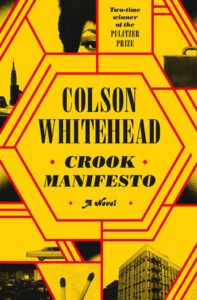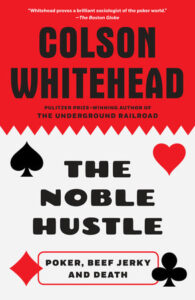(Shame)ful(l) disclosure: the first Colson Whitehead book that I read was The Noble Hustle, rather than his award-winning The Underground Railroad. The reason is simple: while unveiling the mysteries in the early life of legendary alcohol researcher, E. M. Jellinek, I got hooked on crooks and caper stories.
 The Noble Hustle was another book not on my radar but recommended by Nick during one of our many conversations about books we read. This non-fiction, dark comedy takes the reader to a Las Vegas poker tournament, where the narrator and self-proclaimed poker guru underestimates what it takes to play in the major leagues with the big guns – just like Ray Carney, the Black furniture salesman-shop owner, navigating New York City between small-time crooks and big bosses in the Crook Manifesto.
The Noble Hustle was another book not on my radar but recommended by Nick during one of our many conversations about books we read. This non-fiction, dark comedy takes the reader to a Las Vegas poker tournament, where the narrator and self-proclaimed poker guru underestimates what it takes to play in the major leagues with the big guns – just like Ray Carney, the Black furniture salesman-shop owner, navigating New York City between small-time crooks and big bosses in the Crook Manifesto.
Whitehead is planning to complete a trilogy of his Harlem stories happening in the 60s, 70s, and 80s. Set in the 70s, the Crook Manifesto is the second book, a follow-up to Harlem Shuffle, the first novel in the series. With quite a bit of experience on the crooked side, the author guides the reader through a world where the “crooked stays crooked and bent hate straight.”
Whitehead’s crooked New York City is flourishing with uptown crooks, Harlem crooks, old crooks, lifelong crooks, larger-than-life crooks, bonehead crooks, and many more. Among the crooked city fathers, crooked Harlem bankers, crooked white cops, crooked lawyers, and crooked insurance adjusters, even Santa Claus is crooked. “The deeper you went, the more crooked.”
To depict Harlem, Whitehead explores crook gossip, crooked thoughts and crooked enterprises on crooked days, with systemic corruption sanctioned by white politicians and adopted by unremittingly crooked but value-positive crooks who come out of the womb corrupted and busily climb the social ladder.
All his words, all crooked.
However, Whitehead masterfully bends the English language to depict this world of crooked brutality with love and humor. The austere reality of these ugly stories is revealed in a tone that compels the reader to actually enjoy the heist plot line. Whitehead succeeds in making bad guys look good, and inspires the reader to root for them! We want them to pull it off; we want these small crooks to beat the odds.
The telling nicknames of the characters, such as Zippo, Corky, Pepper, and Chink, referring to past experiences, but speaking crook to crook the names also reinforce a sense of belonging. They are all aware that “a man has a hierarchy of crime, of what is morally acceptable and what is not, a crook manifesto, and those who subscribe to lesser codes are cockroaches.” What is it if not trust within one’s own community?
Language helps the reader see the world through their eyes. Carney’s compartmentalization of the language, separating the upstanding citizen / legit businessman and conman, also illustrates the role of secrets in one’s life. For the reader, this masterful language presents a Harlem in all the different ways Carney knows it, shows its parts, and his belonging to a place he loves. Listening to the audiobook version, Dion Graham’s pitch-perfect narration adds greatly to the book’s value. Listen to a sample from the publisher.
 Selected Books by Colson Whitehead
Selected Books by Colson Whitehead
- Whitehead, C. (2023). Crook Manifesto. Doubleday.
- Whitehead, C. (2021). Harlem Shuffle. Doubleday.
- Whitehead, C. (2016). The Underground Railroad: A Novel. Doubleday.
- Whitehead, C. (2015). The Noble Hustle: Poker, Beef Jerky, and Death (First Anchor books edition.). Anchor Books, a division of Random House LLC.
Related from Rutgers University Libraries
- All works related to or by Colson Whitehead available at RUL (including book reviews and newspaper articles written by him and about his work as well as interviews with the author)
Also by Colson Whitehead: Advice to aspiring authors
Many of the recurring questions at author events are related to writing skills and the rules successful authors follow. We picked our favorite pieces of advice from Colson Whitehead on How to Write.
Rule No. 1: Show and Tell, followed by a good nap.
Rule No. 2: Don’t go searching for a subject, let your subject find you. You can’t rush inspiration.
Rule No. 3: Write what you know.
Rule No. 4: Never use three words when one will do. Be concise.
Rule No. 11: There are no rules . . . Most of all, just be yourself.
Source: Whitehead, C. (2012). How to Write [Review of How to Write]. New York Times (1923-), A8–